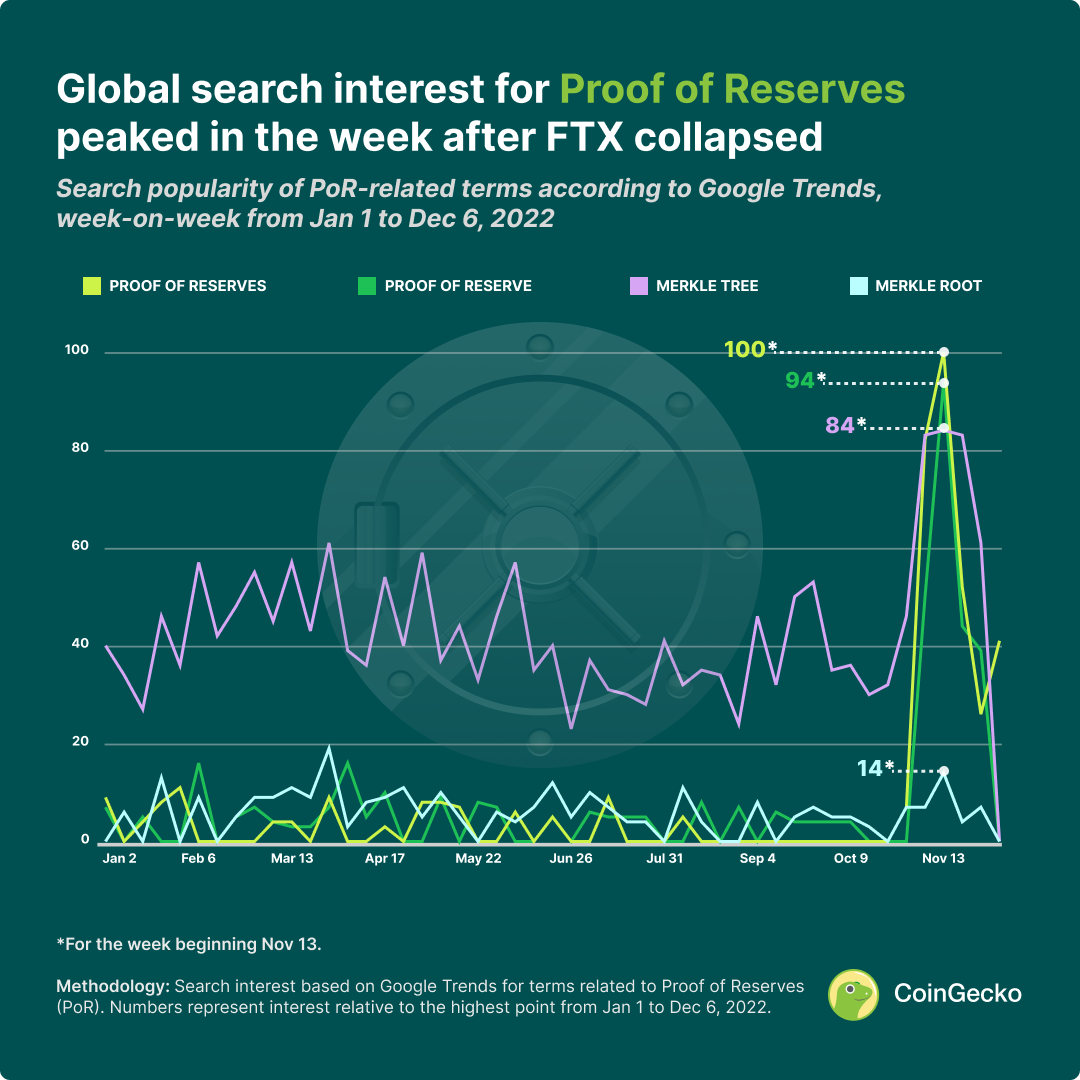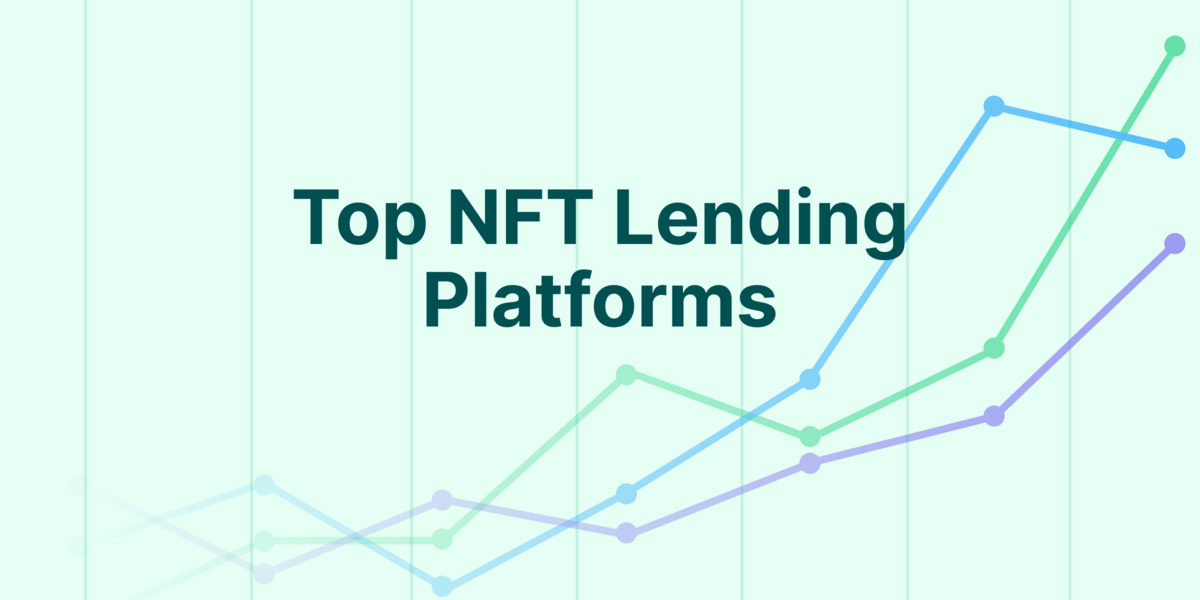
Sam Bankman-Fried’s cryptocurrency exchange FTX halted withdrawals on November 8 when it did not have the liquid assets needed to return funds to customers, and ultimately filed for Chapter 11 bankruptcy protection on November 11. As the crypto community watched FTX suddenly fall from its position as a trusted industry leader, there were increasingly rumors that other cryptocurrency exchanges were at risk of following suit. The unexpected saga sparked renewed discussions about the importance of greater transparency and accountability – such as through Proof of Reserves (PoR) – to enable trustlessness in custodial businesses like centralized cryptocurrency exchanges.
Global search interest in Proof of Reserves-related terms peaked in the week of November 13, as FTX collapsed.
The worldwide search interest for four terms related to PoR grew in the two weeks between October 30 to November 12, as FTX unraveled. In the week of November 13, after the bankruptcy filing, global search interest then peaked for all four terms. This suggests that the crypto community had become more aware of the existence of PoR and were curious to find out more about the concept, as FTX’s collapse dominated media headlines and social media conversations.
The term ‘proof of reserves’, which had had low or insufficient search interest data throughout most of the year, saw search interest pick up from 0 to 7 in the week of October 30. This was followed by an explosive jump of over 11 times week-on-week (WoW) to reach 82 in the week of November 6. Search interest in ‘proof of reserves’ subsequently climbed to the maximum popularity of 100 in the week of November 13, on the back of top cryptocurrency exchanges announcing their plans for public PoR disclosures.
Similarly, ‘proof of reserve’ search interest surged from 0 to 50 in the week of November 6, and almost doubled to reach the second highest search popularity of 94 in the week of November 13. Prior to this, search interest in ‘proof of reserve’ had been sporadic, albeit slightly higher than ‘proof of reserves’. Searchers’ differentiation between ‘proof of reserves’ and ‘proof of reserve’ might be partly due to a current lack of terminology standardization across the cryptocurrency industry, which points to the nascency of PoR.
In comparison, the term ‘merkle tree’ experienced higher and more consistent search interest throughout the year, within a range of 23 to 61. Merkle tree refers to a data structure that can be used to cryptographically verify that cryptocurrency exchanges’ Proof of Reserves match with their Proof of Liability, but also has other applications in cryptography and computer science.
Despite that, search interest in ‘merkle tree’ appeared to have been noticeably impacted by the FTX collapse as well. In the week of October 30, ‘merkle tree’ search interest rose up to 46, from 32 in the previous week. Search interest for ‘merkle tree’ then shot up to 83 in the week of November 6 and peaked at 84 in the week of November 13.
A related term that is more specific to blockchain technology and cryptocurrencies is ‘merkle root’, which refers to a mathematical method for confirming data on a Merkle tree. Search interest for ‘merkle root’ was buoyed to 7 in the week of October 30, reversing a downward trend from previous weeks. The ‘merkle root’ search interest remained the same in the week of November 6, before doubling to 14 in the week of November 13. Notably, this was only the second highest in search interest for ‘merkle root’ for the year, with the peak being a search interest of 19 in the week of March 27.
Combined search popularity spiked by 270% in week of November 6
In terms of a WoW percentage change basis, combined search popularity for these four PoR-related terms saw the highest gains of 270.0% in the week of November 6, as the interest spiked to a total score of 222, up from 60 in the previous week. This represented a significant growth in awareness and interest amid the unraveling of FTX, possibly as a result of people seeking to understand why it was occurring and how to avoid getting caught in the same situation with other cryptocurrency exchanges.
In the following week of November 13, the WoW increase in total search interest was recorded at 31.5%, as the combined popularity of the terms rose up to the peak of 292.
Since then, search interest in Proof of Reserves has declined
As the FTX saga loses its spotlight in the news cycle and becomes replaced by other developments in the cryptocurrency industry, global search interest in the four PoR-related terms have moderated accordingly. Combined search interest declined to 183 in the week of November 20 and subsequently 133 in the week of November 27, representing WoW decreases of 37.3% and 27.3% respectively.
Search interest in ‘proof of reserves’ effectively halved in both those weeks, dropping to 52 and 26 respectively. Although search interest in ‘proof of reserve’ and ‘merkle root’ more than halved in the week of November 20, both managed to sustain in the next week at 39 and 7 respectively.
The only exception was the search interest for ‘merkle tree’, which remained elevated at 83 in the week of November 20. In the following week of November 27, ‘merkle tree’ search interest returned to 61, which was its highest search interest before the spike from FTX’s collapse.
With search interest currently on the decline, it remains to be seen whether the FTX collapse will mark a turning point towards the successful implementation of PoR, in order to attain much-needed transparency and accountability from cryptocurrency exchanges, or if PoR will be forgotten again.
Methodology
The study examined weekly search interest for a non-exhaustive list of terms related to the concept of Proof of Reserves, namely ‘proof of reserves’, ‘proof of reserve’, ‘proof of liability’ and ‘merkle tree’, based on Google Trends data. The terms ‘proof of reserves’ and ‘proof of reserve’ were included as separate terms, as the divergences in search interest indicated that they were not being considered synonymously by people searching about the concept.
Other terms considered but not included were ‘proof of asset’, ‘proof of assets’, ‘proof of liability’ and ‘proof of solvency’, due to insufficient search interest data or the term currently being primarily used in a non-cryptocurrency context.
The location setting was ‘Worldwide’ and the time range was set from January 1 to December 6. The two remaining parameters were left to the default options of ‘All categories’ and ‘Web Search’.
The numbers represent search interest relative to the maximum popularity compared across the terms, for a selected location and time. A value of 100 indicates maximum popularity and a value of 50 indicates half the popularity, while a score of 0 means there was insufficient search interest data for the term.
All dates stated are in 2022.

If you use these insights, we would appreciate a link credit to this article on CoinGecko. A link credit allows us to keep supplying you with future data-led content that you may find useful.
Looking for more information on what happened with FTX? Check out this study we did on How Many Crypto Whales have BTC or ETH On-Chain?

Yuqian is a crypto research analyst at CoinGecko, covering a range of topics from NFTs to ETFs, crypto adoption and interest, and beyond. She's especially fascinated by the philosophical and socioeconomic aspects of crypto. She holds a Bachelor of Social Sciences with Honors from the National University of Singapore. Follow the author on Twitter @solosbrqt





 Or check it out in the app stores
Or check it out in the app stores
